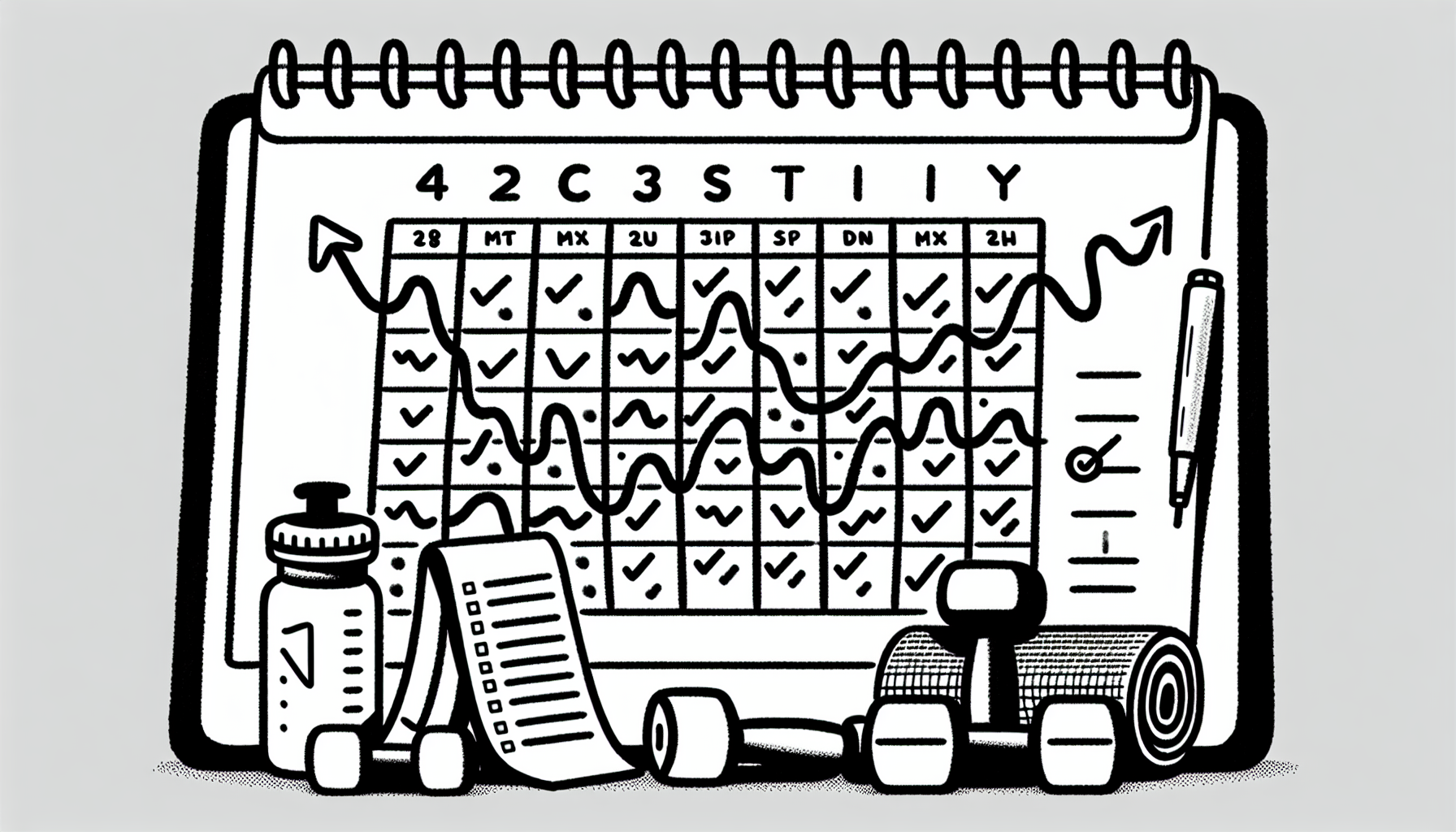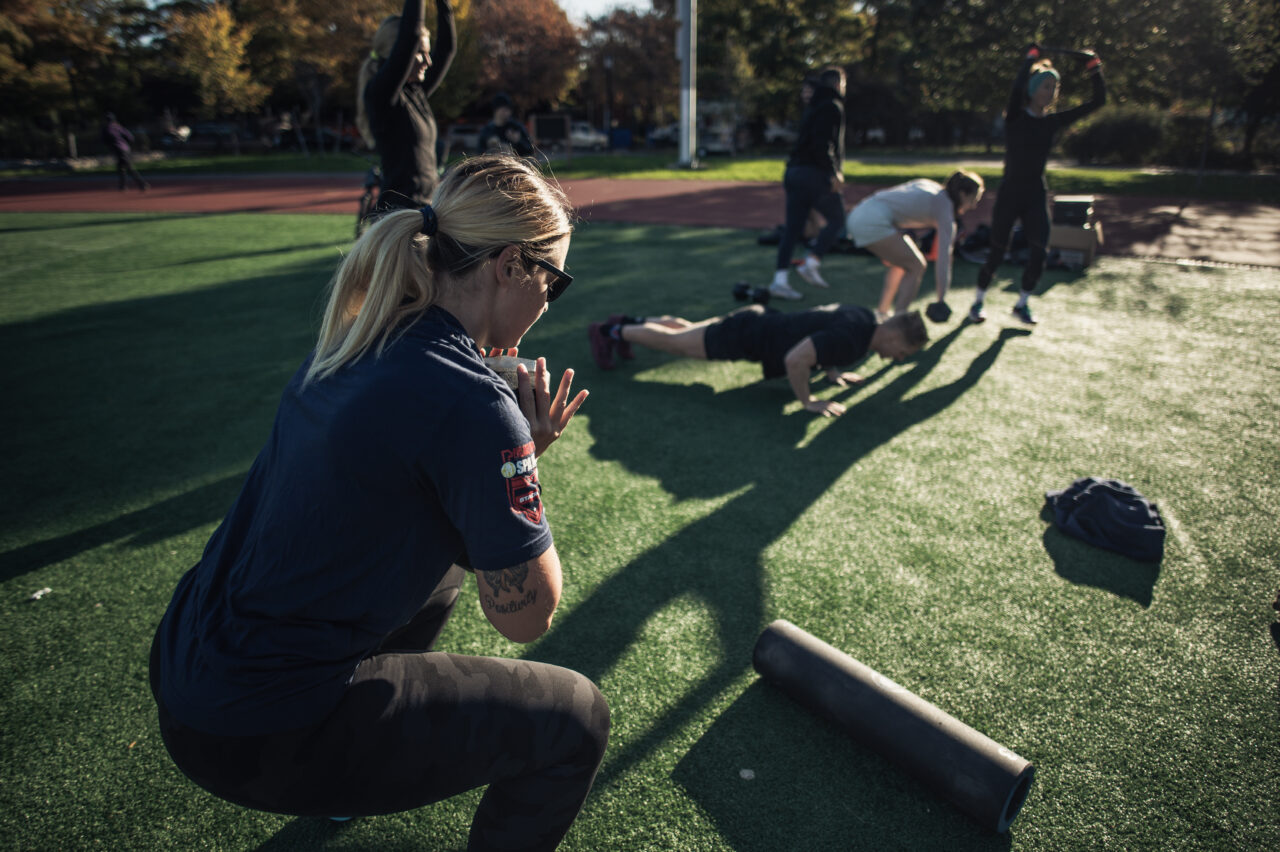Taking the first step into working out for beginners can feel like a leap into the unknown. Our guide strips away the complexity to answer what you really need to know: how to set attainable fitness goals, where to start, and how to progress. In short, actionable segments, you’ll learn how to create a workout routine that blends cardio, strength, and flexibility—a well-rounded foundation for lasting fitness success.
Consider this: The Very Beginner workout plan
Got questions? Send us a message on Instagram (@humanfitproject).
Key Takeaways
- Start your fitness journey with realistic, achievable goals, and get medical advice if necessary to tailor your workout routine to your health conditions.
- Create a sustainable workout program that includes varied forms of exercise such as cardio, strength training, and flexibility exercises, and ensure it adapts to your increasing fitness levels.
- Overcome common exercise obstacles by managing your time effectively, staying motivated with trackable goals and accountability, and finding enjoyment in diverse physical activities.
Embarking on Your Fitness Journey: Key Considerations

Beginning a fitness plan has the potential to bring about amazing changes. It is more than just breaking into a sweat. It can be an essential step for establishing improved health habits. In order to get started on this journey you have to set realistic goals that are stimulating but also manageable enough not be overly disheartening when trying your best. Keep in mind that every effort matters so even if progress seems minuscule, don’t discount its importance.
Also, assessing present physical condition plays an important role as well since it helps create personalized routines based upon individual needs and limits at hand rather than taking part in blanket practices which might lead you astray from reaching personal aspirations or cause harm due to inadequate preparation.
Setting Realistic Goals
Beginning a successful physical fitness plan requires setting realistic objectives. Whether you are looking to slim down, gain muscle mass, or simply become more active overall. Your goals should be specific and quantifiable yet achievable at the same time. This is essential because it raises your probability of success while also keeping you motivated along with aiding in increasing muscular tissue properly.
To come up with sensible aims that fit within yourself individually, consider all aspects like current level of fitness, any available restrictions on time as well as personal preferences too. Start small by introducing some subtle modifications into daily life – for example if there has been no activity previously don’t strive toward running several miles during the initial week instead look toward taking 15 minutes each day performing brisk walking before slowly escalating amount and duration spent exercising over time as capability improves itself. Remember even great feats begin from one singular action so never give up.
Determining Your Fitness Level
To reach your fitness goals, it is important to evaluate your existing level of physical conditioning before beginning a workout routine. With the right amount of knowledge and preparation, you can avoid injury as well as unnecessary strain on the body while optimizing for success by choosing workouts that best fit where you are at in terms of fitness levels.
So how do we measure our current status? There are running or jogging tests for cardiovascular fitness. Push-ups and pull-ups measure upper-body muscular strength and endurance. And something as simple as a sit and reach can evaluate flexibility. From there, there are various other “tests” which assess strength, speed, power and cardiovascular health.
Keep all this in mind when starting off with exercises meant specifically for beginners, so taking small steps forward will help achieve better results rather than rushing into intense training regimens too soon.
To start out slow, check out our Very Beginner Workout plan (VBWP), and start getting fit with us.
Health Concerns and Consultations
Before beginning your new workout plan or activity plan, it is crucial to get medical clearance if you have any underlying health issues such as diseases of the digestive tract and kidneys, limited mobility, heart disease, asthma diabetes or hypertension. Discussing with physicians can guarantee that your workout routine works well for particular conditions while being safe at all times.
Medical inspection might be a must when those who are vulnerable – newbies in exercises, should obtain authorization from their doctor prior to starting. It’s noteworthy that exercise usually yields positive results even among people suffering long-term illnesses like strengthening one’s heart muscle, managing blood pressure levels, and more. Performing workouts regularly helps diabetic people keep up good glucose control & better insulin level sensitivity.
Related: How to instantly start improving your health
Building a Balanced Exercise Program

Creating an exercise plan that supports your individual fitness goals and current physical ability is the first step to reaching optimal health. This includes having a combination of cardiovascular exercises for increased endurance, strength training routines designed to build muscle, as well as flexibility work-outs enabling mobility in different parts of the body.
A successful workout program requires finding activities you find enjoyable because it’s much easier this way. Whether it’s running or swimming, weightlifting sessions, yoga or Pilates classes, choose something exciting so you can stay motivated and have fun while taking care of yourself at the same time. Remember: An effective overall routine should include elements from all areas such as cardio workouts, strength building sets along with stretch exercises in order to reach full potential when striving towards maximum results within any given sport/activity goal.
Cardio Workouts for Beginners
Interested in building your endurance? Cardio workouts are an excellent way to get started. From improved cardiovascular endurance and bone density, better sleep, stress relief and endorphin boosts – there’s plenty of benefits. Examples could be brisk walking, running, cycling or rowing. You can also do the run/walk method where you take breaks between short jogs for a few minutes each session. To begin with, start at 20-minute intervals then aim for 3-4 cardio sessions per week which last from 20 to 40 minutes apiece, listening out for your body if rest is needed in between exercise programs would be ideal too.
Related: How to start running for the first time
Strength Training Basics
Strength training is an essential part of any effective fitness program and it helps to create muscle mass, increase stamina, protect bones & joints as well as reduce the chances of developing heart disease or diabetes. For those just starting out, a beginner workout plan incorporating 10-12 reps on resistance machines or free weights can help you establish a strong base of fitness. To build size & strength, incorporate heavier weights with fewer repetitions – known as progressive overload, which will aid in muscular development while pushing yourself beyond what was possible before. Keep up this gradual progression and never cease working hard towards success. Check out our list of 35+ free workout plans for different abilities and fitness levels.
Flexibility and Mobility Exercises
Exercises aimed at flexibility and mobility are just as essential to one’s fitness routine as strength training or cardio. Maintaining a good range of motion for your muscles and joints helps you move better, enhance performance, and maintain total physical health. Including activities such as 20 minutes per day of standing quad stretches, runner’s lunges, eagle arms stretching, downward-facing dog poses (or Cat/Cow), walking lunges with hip circles can do wonders in keeping the body supple while maximizing its potential agility through ankle mobility exercises like glute bridges or Spiderman lunge along with thoracic spine windmills. For a couple good options here, check out our daily winddown routine and our low intensity workouts your body will love.
Creating a Sustainable Workout Routine

Creating a successful workout regimen is dependent on consistent participation, time management and incremental improvement. Regular exercise routines are essential to forming ongoing fitness habits that reduce stress levels while elevating mental well-being. They help guarantee physical activity will become an integral part of daily life, just what any personal trainer would recommend for sustaining long term fitness results.
With this in mind, one must plan workouts ahead carefully as if it were nonrefundable engagements, utilizing their strengths to ensure exercising receives the same focus as work or family duties do. Lastly, gradually increase your intensity of movement, duration or resistance used when training so that with each step up there can be progress made and muscles strengthened since continually growing stronger relies upon having challenges overcome by adapting bodies appropriately at appropriate level increments.
Consistency is Key
To maintain consistency in your fitness routine, think about the advantages of exercising frequently. Remember how good you feel after a workout and also remember the milestones that have been achieved since starting this journey with fitness goals. If boredom starts to set it during workouts, switch up activities by trying new exercises or changing routines while challenging yourself throughout each session – all of which keeps one motivated and excited for what’s next.
Read also: How to stay motivated
Scheduling Your Workouts
If you want to meet your fitness goals and gain optimal health benefits, it’s essential that exercise is incorporated into your day-to-day routine. With 150 to 300 minutes dedicated each week specifically towards moderate aerobic activity, setting aside the necessary time might seem overwhelming, but simply breaking up this amount of time between several days works out perfectly. Decide when would be most suitable for working out. Some people find mornings more productive while others prefer evenings better. No matter what, making sure not to miss those workouts should be a top priority like any important appointment or meeting in life. Staying consistent with training will bring favorable results over time, so stick with a plan that suits best for you personally.
Gradual Progression
Gradual progression is the key to ongoing progress, ensuring that your body adapts to continually rising levels of difficulty and challenge. Progressive overload provides an excellent approach here. It involves increasing weight lifted, number of repetitions done or duration spent on each exercise in order for muscle growth not to plateau out. While doing this, you must pay close attention to your body’s signals – if workouts feel too easy now, improved endurance plus excessive soreness could be signs for more intense exercises ahead.
Overcoming Common Exercise Obstacles

Starting a fitness journey can be both exciting and intimidating. Finding time, staying inspired, and feeling comfortable at the gym are all common issues that may arise. Overcoming these challenges is possible with proper planning of workouts and having an encouraging mindset to rely on.
Time management plays a major role in efficiently utilizing your busy schedule for exercise sessions while tracking progress will help you stay motivated along the way. Remembering that being anxious about going to gyms isn’t unusual, especially if you’re just getting started, but it’s totally manageable when equipped with the right tools & approaches, this makes achieving success in building physical fitness much more doable.
Time Management
Despite time constraints, regular exercise should still be prioritized as an essential part of maintaining good health. Making workouts a firm appointment in your schedule and adhering to physical activity guidelines can help ensure you find the time for them. Quick exercises like chair squats or wall sits during short breaks throughout the day will keep one energized all day while also ensuring they have completed their daily exercise requirements. These simple exercises could include planking, calf raises, and shoulder shrugs. Push-ups and lunges alongside vinyasas plus walking jogging on spot and jumping jacks with more intense incline pushes ups., Squats and sit-to stands adding neck bends, circles side stretches combined chin-to–neck motions providing additional benefits too.
See also: The best exercises to do at your desk
Motivation and Accountability
Achieving long-term success through regular exercise requires staying motivated and accountable. Here are some tactics to help make this happen: tracking progress, seeking personalized feedback, involving friends or family in physical activities, setting specific workout goals with check-ins on progress and partnering up for workouts. When following these strategies, there will be a better chance of keeping dedicated to the fitness routine desired.
Likewise, intrinsic motivation is an important factor when it comes to committing oneself consistently to exercising. Which can mean appreciating what one does as well as feeling great about their own efforts while doing something they love. By having that mindset, self discipline will stay consistent enough until reaching any objective established by performing whatever form of working out chosen at each moment.
Fear of the Gym
Many novices frequently find themselves struggling with “gymtimidation” or gym intimidation. This can be conquered by learning more about the environment of a fitness center, comprehending how to utilize various equipment and seeking guidance from trainers or experienced people at the gymnasium.
Starting off using beginner-friendly pieces of apparatus such as: dumbbells, barbells, leg press machines. Pull-downs, rowing machines, cables, chest presses – all these will help improve one’s assurance levels. Everyone in that facility was once an amateur too, so most individuals are focusing on their own workouts instead of judging others harshly. Thus don’t let fear hold you back from achieving your desired fitness goals. Working out should not be something which intimidates, but rather it is meant to empower and promote positive results related to physical health.
Read also: Getting over a fear of the gym
Making Exercise Enjoyable and Rewarding

To maintain a long-term fitness plan, it is essential to make your exercise both pleasing and fulfilling. To do this, discover activities that you enjoy doing, introduce diversity into your routine and insert rewards as well as intrinsic motivation. By making physical activity something you look forward to every day or week, the probability of keeping up with it in the future increases significantly.
You can ensure that workouts remain enjoyable by investigating multiple sports options suitable for achieving fitness objectives. Taking advantage of online quizzes designed for finding out what type of exercises best suit individuals’ tastes. Adding various elements to training sessions so they don’t become dull quickly. Finally, integrating rewards while going through an intense fitness program provides considerable sense of accomplishment thereby encouraging continuous effort towards achieving desired results when following these routines.
Finding Activities You Love
It’s important to make your exercise routine something that you can enjoy and stick with. To find the best workout for yourself, it may be necessary to experiment by trying various exercises until you identify what appeals most to your preferences. There are plenty of activities available so take some time and select one which works well for you. Remember though: Exercising should bring pleasure not stress, so pick an activity which makes fitness enjoyable in order to sustain engagement over a long period.
Adding Variety to Your Routine
It’s important to introduce a variety of activities into your workouts in order to make them both interesting and effective. Doing so provides an ever-changing challenge for the body, leading to improved progress. It serves as a great way to maintain motivation levels while helping achieve better overall fitness results.
To mix up your exercises try incorporating different methods or altering intensity/duration during workout sessions, such as cycling if running is usually done for cardiovascular training and resistance bands instead of weights when focusing on strength building movements using the bodyweight alone. Remember that introducing fresh approaches helps ensure continual advancement by keeping engaging with new physical challenges as well as adding excitement.
Incorporating Rewards and Intrinsic Motivation
To make a lasting and fulfilling fitness regimen, use rewards as well as intrinsic motivation to stay focused. Keeping track of progress and cheering your accomplishments can help reach these goals. To aid in commitment, find physical activities that you enjoy doing – like playing sports or going for a hike – and create an encouraging environment with other people who also have similar ambitions when it comes to exercise and health initiatives. By integrating benefits associated with exercising along with the enjoyment taken from its pursuits, you will be able to achieve sustainability throughout your workout routine.
Prioritizing Your Fitness Long Term
Beginning a fitness quest can be an enriching and life-altering experience. It’s not just about losing pounds or developing muscle. It involves establishing healthier habits and transforming into the most ideal version of yourself. Take note that remaining consistent, making gradual improvements, as well as enjoying your activity, are essential to sustaining a regular exercise plan over time – so go ahead lace up those trainers, fix some goals for yourself then get going. Your future self will appreciate this effort you make now.
Frequently Asked Questions
To learn more, check out of list of the 21 most frequently asked questions we get about working out.
How should a beginner start working out?
Now is an ideal time to embark on your fitness journey and watch yourself improve day-by-day. To start, include short periods of activity throughout the day like a brisk walk for 20-30 minutes. Gradually work up to a moderate level while making sure not exceed 10% more every week. If you have any doubts, get help from professional health or fitness experts.
What type of workout is best for beginners?
For those just beginning, bodyweight workouts are an excellent way to begin developing total strength and flexibility. To get the ball rolling, here is a suggested introductory workout which uses only one’s own body weight as resistance. Remember that incorporating such exercises into your routine will help you take charge of your fitness journey.
How long should beginners workout?
It is advised that a workout for beginners should last roughly between 30-40 minutes. It’s imperative to take time during your session and listen to what your body needs. Taking frequent breaks to stretch will help you recuperate, so be sure not to push yourself over the limit.
What workouts should I do first?
As recommended by the American College of Sports Medicine, when beginning your fitness routine it’s best to start with exercises that target larger muscle groups. This approach is ideal for meeting most types of goals and suitable for a wide range of people.
How do I set realistic fitness goals?
When it comes to setting fitness goals, consider your current level of fitness and other factors such as how much time you have available and what activities you prefer. Start small with making adjustments to your routine which can be gradually increased over time in proportion with improving physical condition. Make sure that these achievable objectives will help advance your overall health. You’ve got this – just take the steps necessary for success when planning out a customized program based on personal preferences and capabilities.

